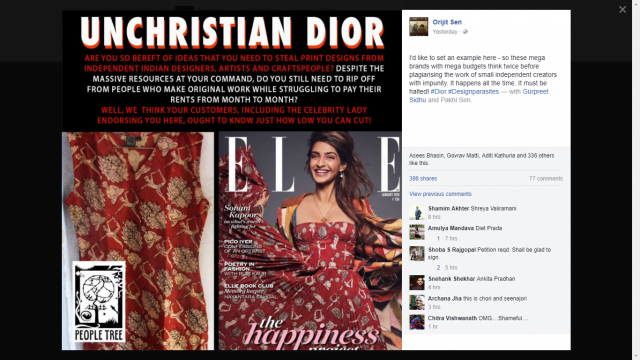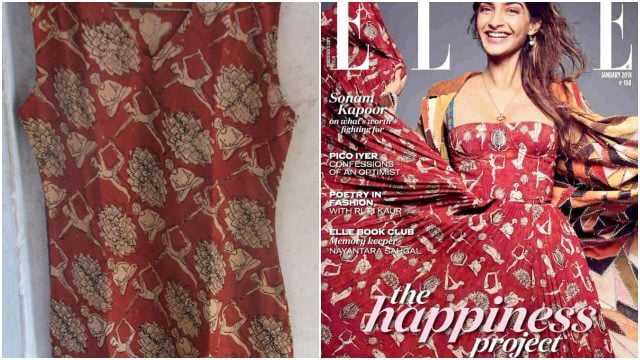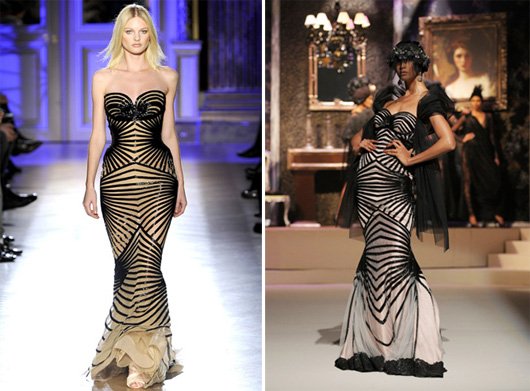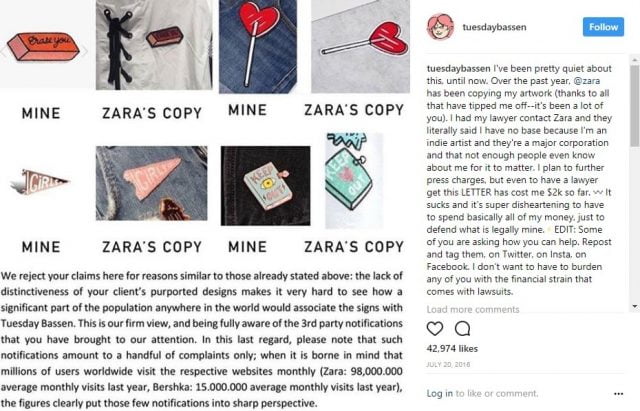When one thinks of terms like ‘copy’, ‘looking same’ and ‘taking inspiration’, the first thought would be of Indian artists taking help from a western product to create their own.
However, it is extremely rare to see it happen the other way wherein a western artist blatantly takes inspiration (read: copy) from an Indian designer. It appears the ‘blue moon’ day has come in this context with news about popular international luxury brand Christian Dior basically copy-pasting an Indian designer’s work.
On Monday, Orijit Sen, co-founder of People Tree (the victim brand) made a post informing people about how Dior had straight up just taken one of their designs as it is without any kind of credit, payment or official permission to use those designs.

Sonam Kapoor was first seen wearing the allegedly plagiarized designs on the cover of the January edition of Elle India.
Why Did You Do It, Dior?
The prints on first glance are extremely similar to each other and it is hard to believe it’s all a coincidence.

People Tree, that Sen and his wife Gurpreet Sidhu run is a sustainable fashion brand that has been selling such block-dyed prints on textile since the 1990s. Since this brand’s ethos lies in making artisanal products with creativity, they are not mass produced and only a few pieces are created at a time.
Pakhi Sen, the daughter of the founders also posted on Facebook addressing this issue and highlighted how this is insulting to independent and “small businesses and artists” that have to struggle much more than such high-end brands, which are flush with funds.

Read More: Christian Louboutin Teams Up With India’s Top Designer To Create Unrealistically Stunning Footwear
Just the fact that a brand as big and reputed as Christian Dior can copy so blatantly is indicative of the rampant plagiarism that exists on both ends of the water. Although Sen, as reported by news sources, stated that there are a few minor modifications, they are not enough to completely make their designs original.
But of course, if an Indian does it then suddenly, very hypocritically, it is something to be mocked over and brought to light in order to show how we have no creativity and all of it lies on the western shores only.
However, if a brand like Dior does it then automatically it becomes a case of ‘inspiration’ being taken and we are made to feel as if we should be honoured that such Indian designs are being used and ‘noticed’!
Not justifying the plagiarism or copying that we do on our end because it is not correct no matter who does it, in fact, it is doubly insulting when the truth finally comes out and further cements the stereotype that Indians have no creativity of their own.
To see a few glaring examples of how even we have been extremely guilty of outright copying and plagiarism with international design, please check out this piece:
PLAGIARISM OR INSPIRATION: COPYCAT INDIAN DESIGNERS

How Exactly Did This Pass The Check?
It is also shocking as to why this was not something that was dealt with during the designing process only. Dior is not a small brand with a handful of team members that they could not come up with original designs, or find out if another such design already existed.
The brand is known worldwide and has branches across several cities in various countries, so just imagine the number of employees and in turn the resources they must have at their disposal.

Plagiarism in fashion is quite common and it is not always the small brands copying the big ones. Apart from Dior, even Forever21 has been accused of plagiarism and Zara has come under fire several times for plagiarising designs from almost a dozen artists over the years.

As per this post by Businessworld, Tarun Tahiliani, a reputed Indian designer noticed that the lack of patent culture in the industry plays a big role as to why it is so easy to plagiarise.
High time we do something about it?
Image Credits: Google Images
Sources: First Post, Businessworld, Business Insider India + more
Other Recommendations:
http://edtimes.in/2018/01/why-is-loreals-hair-campaign-starring-a-hijabi-model-breaking-barriers/





































